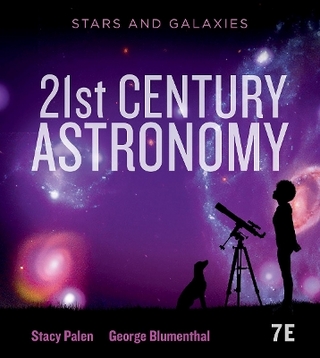
Handbook of Gravitational Wave Astronomy
Springer Verlag, Singapore
978-981-16-4307-1 (ISBN)
- Titel wird leider nicht erscheinen
- Artikel merken
This handbook provides an updated comprehensive description of gravitational wave astronomy. In the first part, it reviews gravitational wave experiments, from ground and space based laser interferometers to pulsar timing arrays and indirect detection from the cosmic microwave background. In the second part, it discusses a number of astrophysical and cosmological gravitational wave sources, including black holes, neutron stars, possible more exotic objects, and sources in the early Universe. The third part of the book reviews the methods to calculate gravitational waveforms. The fourth and last part of the book covers techniques employed in gravitational wave astronomy data analysis. This book represents both a valuable resource for graduate students and an important reference for researchers in gravitational wave astronomy.
Cosimo Bambi is Xie Xide Junior Chair Professor at the Department of Physics at Fudan University. He received the Laurea degree from Florence University in 2003 and the PhD degree from Ferrara University in 2007. He was appointed as a postdoc at IPMU/The University of Tokyo (Japan) and at LMU Munich (Germany). He joined Fudan University at the end of 2012 under the 1000 Young Talents Program. His main research interests focus on black holes and observational tests of gravity models. He has published more than 150 papers on high impact factor refereed journals as first or corresponding author, he has over 7,000 citations, and his h-index is 46. He has published several books with Springer, either as author and editor. He has received a number of awards, including the 2018 Magnolia Silver Award for outstanding contributions to Shanghai's development and the Xu Guangqi Prize as the best Italian scholar in China. Stavros Katsanevas is Professor Classe Exceptionnelle 2, Universite Paris Denis Diderot, France. He received his PhD degree from Athens University in 1985. He was appointed as the director of the European Gravitational Observatory (EGO), the laboratory that manages the VIRGO interferometer, funded by CNRS, INFN and Nikhef in 2018. His research interest includes supersymmetry, neutrino physics, astroparticle physics, novel photodetectors and distributed systems of smart sensors, and recent achievement includes the main supersymmetry generator of the LEP experiments: SUSYGEN and supersymmetry phenomenological papers, the design of the neutrino beam from CERN to Gran Sasso, the design and realisation of a new hybrid photodetector of high sensitivity, high spatial and time resolution and the design of a very large distributed system for "intelligent" sensors for the neutrino experiment OPERA. Prof. Katsanevas has co-authored over 400 publications, in the context of more or less large experimental collaborations and a few phenomenological studies, reviews, or new detector concepts with a small number of authors. Kostas Kokkotas, Professor (Chair) for Theoretical Astrophysics, Institute of Astronomy and Astrophysics, University of Tubingen. BSc in Mathematics (1981, U. of Thessaloniki), MSc in Applied Mathematics and Astronomy (1985, U. of Wales, Cardiff), PhD in Physics (1988, U. of Thessaloniki). From 1990 till 2007 served in the Physics Department of U. of Thessaloniki as Lecturer, Assistant, Associate and Full Professor of Relativity). In 2007 he moved in the present position at the U. of Tubingen. Since 2010 he is Adjunct Professor at Georgia Institute of Technology and in 2017 he was elected as Honorary Professor in the U. of Thessaloniki. He supervised over 50 BSc and MSc thesis, 14 PhD thesis and mentored 30 postdoctoral researchers. He has taught General Relativity, Numerical Methods, Relativistic Astrophysics, Classical Field Theory and 1st year Mathematics and Physics in both Thessaloniki and Tubingen. He served as core member of various international research initiatives (VESF, EU Marie Curie networks, COST actions), PI & Spokesperson for the Section "Gravitational Waves: Theory and Sources" of the European program "Integrated Large Infrastructure for Astroparticle Physics (ILIAS)", and elected member of national and international scientific societies such as, member of the Governing Council of International Society for General Relativity and Cosmology, Chairman of the Hellenic Society for General Relativity and Cosmology. Member of Scientific Advisory Boards of Institutes and Departments in various European countries and Managing Editor for IJMPD. His research interests are related to theoretical studies of Gravitational Waves Sources with emphasis in the Dynamics of Neutron Stars and Black-Holes. He published over 200 research articles in refereed journals and more than 20 invited review articles.
Please refer to the attachment tab for the full version of table of contents
| Erscheint lt. Verlag | 10.7.2022 |
|---|---|
| Zusatzinfo | 200 Tables, color; 344 Illustrations, color; 37 Illustrations, black and white; XX, 1860 p. 381 illus., 344 illus. in color. Print + eReference. |
| Verlagsort | Singapore |
| Sprache | englisch |
| Maße | 155 x 235 mm |
| Themenwelt | Naturwissenschaften ► Physik / Astronomie ► Astronomie / Astrophysik |
| Naturwissenschaften ► Physik / Astronomie ► Relativitätstheorie | |
| ISBN-10 | 981-16-4307-5 / 9811643075 |
| ISBN-13 | 978-981-16-4307-1 / 9789811643071 |
| Zustand | Neuware |
| Haben Sie eine Frage zum Produkt? |
aus dem Bereich

